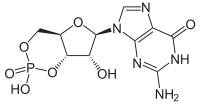
Photo from wikipedia
Cyclic guanosine monophosphate–adenosine monophosphate (cGAMP) synthase (cGAS) detects infections or tissue damage by binding to microbial or self-DNA in the cytoplasm. Upon binding DNA, cGAS produces cGAMP that binds to… Click to show full abstract
Cyclic guanosine monophosphate–adenosine monophosphate (cGAMP) synthase (cGAS) detects infections or tissue damage by binding to microbial or self-DNA in the cytoplasm. Upon binding DNA, cGAS produces cGAMP that binds to and activates the adaptor protein stimulator of interferon genes (STING), which then activates the kinases IKK and TBK1 to induce the secretion of interferons and other cytokines. Recently, a series of studies demonstrated that the cGAS-STING pathway, a vital component of host innate immunity, might play an important role in anticancer immunity, though its mechanism remains to be elucidated. In this review, we highlight the latest understanding of the cGAS-STING pathway in tumor development and the advances in combination therapy of STING agonists and immunotherapy.
Journal Title: Frontiers in Immunology
Year Published: 2023
Link to full text (if available)
Share on Social Media: Sign Up to like & get
recommendations!